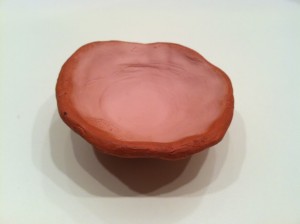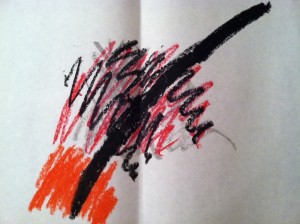Have you had concerns about making “ugly” artwork when engaging in art therapy?
This is the fourth post of the art therapy** series, based upon the graduate class I’m taking in art therapy for clinical social work, and it will be addressing this very topic.
This post will illustrate that being worried about making something unattractive was a rather common concern amongst my classmates and I (and is likely to be so for our clients) but that the “beauty” of the art is not what matters. Rather, it is the process of making the art and the expression of the emotion that are key.
Moving onto last week’s class, we worked with clay for the very first time. It was fun and quite messy 🙂
Our (first) assignment: Make whatever we like
This was essentially a warm-up exercise for us to get familiar with the material. Some of my classmates had never worked with clay before; others have but only on a wheel.
For me, this assignment ended up having two parts: a warm-up part in which I made the above small bowl (reminiscent of my experience in making bowls on a wheel) and a second part which I will describe in some detail.
After completing my bowl, I was feeling relaxed because I had completed the assignment of “making whatever I like.” This meant that whatever I was going to make now was above and beyond the required and so I just let myself play with the clay and feel whatever I was feeling.
As I was playing with the clay, my mind filled up with thoughts about someone who is near and dear to me who is battling cancer and I was feeling terribly sad and worried after a recent development.
Before long, my hands were twisting and turning the clay and I found myself with a long twisted piece of clay looking to me like my dear friend’s spread-out colon (the place where his cancer had originated).
This long piece of colon looked to me so ugly. It was truly ugly – it was where the cancer had started attacking my dear friend. I also didn’t feel comfortable with it looking almost like poop.
I was afraid what everyone would think and thus, I destroyed it. Instead, I decided to make a safer non-ugly item, a (rough) model of my dear friend. While I was making it, I was feeling very sad and had some tears run down the side of my face.
Skipping ahead to part of this week’s class, the topic of making “ugly” art was on the agenda. This was because it had become apparent in our private “class-only” blog that there were a number of us who had trouble with making “ugly” art. Many of us were wondering how to get over this hurdle and how to help clients who may suffer from the same inhibition.
Our professor asked us what we associated “ugly” or an “ugly” picture with, and the following words came to mind: painful, shame, gross, inadequate, frustrating, disgusting, taboo__lust, libido, suicidal/death thoughts, anger-rage/murder, fear and envy/jealousy.
Conversely, for the word “good,” the following words were mentioned: pretty, appropriate/acceptable, perfect, professional-looking and others want it/desirable.
To further help us deal with our “ugly,” we were asked to think about what pops up for us when we feel our work is inadequate, not pretty or we don’t like it and then to go ahead and make a drawing. Below is my picture of “ugly.”
It was the strangest thing for me to let those feelings out. I’ve certainly felt them before but I’ve never given them a voice, so to speak, before. Right after I finished, I turned over the page and didn’t want to look at my “ugly” anymore.
Now, when I look at my “ugly,” it doesn’t seem as ugly as it did before and I feel some relief at having expressed my emotions in this manner. I recall that when making my “ugly,” I had pressed down hard and used the cray-paz in a rather rough and dark manner (most uncharacteristic of me).
Before reading McMurray and Schwartz-Mirman (2001), I had always interpreted and experienced this awful feeling as inward-directed. However, now I think that when I have been feeling my pain, I have also been expressing some repressed anger and rage towards someone who had hurt me when I was a child.
Key Takeaways:
- The goal in clinical art therapy is not to create “beautiful” art or art for public display but rather, to encourage the client to express exactly what is felt, regardless of how pleasing or unpleasing the result will be to the eye (D. Fagen, Creative arts therapy in clinical social work lecture, March 19 & 26, 2012; Marxen, 2011).
- When working with clients, it is important to create a space for whatever shows up – for it not be ignored, shut down or judged. It is only by creating a safe space for clients that they may feel safe to express their emotions (D. Fagen, Creative arts therapy in clinical social work lecture, March 26, 2012).
- By accompanying and supporting our clients (and following the 11 Tips for Employing Art Therapy Techniques), you help create a safe space for them. This, in turn, helps them find their own form of artistic self-expression through which to externalize their emotions (D. Fagen, Creative arts therapy in clinical social work lecture, March 19 & 26, 2012; Marxen, 2011).
- According to McMurray and Schwartz-Mirman (2001; p. 311), “the core of the creative process is the translation of the unconscious primitive impulses and fantasies into tangible forms in the present, using art materials.”
- The artwork created in art therapy serves as an external tangible substitute that enables safe distancing from primitive impulses and fantasies that were originally aimed towards the significant figures in early life (McMurray and Schwartz-Mirman, 2001)
- The employment of art therapy, that is, the provision of ongoing, consistent and flexible activity of art materials, enables varied and repeated examination of early object relations. This, in turn, enables the ego to gain gradual control over the (and/or the working through of) previously repressed primitive impulses and fantasies (McMurray and Schwartz-Mirman, 2001).
Finally, if you can, please check out McMurray and Schwartz-Mirman (2001) for a wonderful illustration of a boy who worked through his need to to always be well-behaved and good through repeated creation of “cute things” in their varying forms, as well as his fear of expressing anger and aggression through the repeated and varied creation of things he termed as “revolting things.”
Have you made some “ugly” art and if so, what feelings did it evoke in you both during and afterwards? Have you had an experience working with clay (or play-doh) with a client that you would like to share?
And for the art therapists out there, what questions would you ask to help me interpret my “ugly?”
You May Also Enjoy:
New Social Worker: Different Strokes: Art & Photo Therapy Promote Healing
**Caveats:
1) I am a social worker and not an art therapist. The above information is only meant to be seen as a taste of what is involved in art therapy.
2) Please do not substitute material on this site for consultation with an art therapist or mental health professional. It is not intended to serve as mental health advice, let alone assessment, diagnosis, or treatment.
3) Before practicing art therapy, one must obtain sufficient training, supervision and licensing. So You Want to be an Art Therapist, Part Two: Art Therapy Education describes some of the different paths available to those interested in art therapy as a profession or as an additional technique for those who have a master’s degree in licensed mental health professions like counseling and social work.
References:
D. Fagen, LCSW, LCAT, ATR-BC, Creative arts therapy in clinical social work lecture, March 19 and 26, 2012.
Marxen, E. (2011). Pain and knowledge: Artistic expression and the transformation of pain, The Arts in Psychotherapy, (38), 239-246.
McMurray, M. & Schwartz-Mirman, O. (2001). Integration and working through in art therapy, The Arts in Psychotherapy, (28), 311-318.




Dorlee,
Over the last few years, I’ve been reading a lot about this very topic. The idea of accepting both sides – the dark and the light, the pretty and the ugly, the up and the down. The duality of life.
It’s a simple concept, but one that can be hard for us to accept.
By accepting or surrendering, we let go. I think often we think of “letting go” as “giving up”, which it isn’t.
It’s interesting how when you no longer judged your creation, you looked at it with new eyes.
Thanks for opening our eyes by sharing what you’ve learned.
Thanks so much, Marianna, for sharing your thoughts and reactions.
You raised such an interesting concept – the duality of life…
The Gestalt approach to therapy specifically addresses the fact that we tend to encompass everything that we think we are as well as the opposite (what we would like to believe that we are not).
It is by becoming aware of this duality and accepting it that you become free – no longer rigid and afraid of your polar opposite. You become more flexible and are living as a more authentic, freer self.
Thanks again!